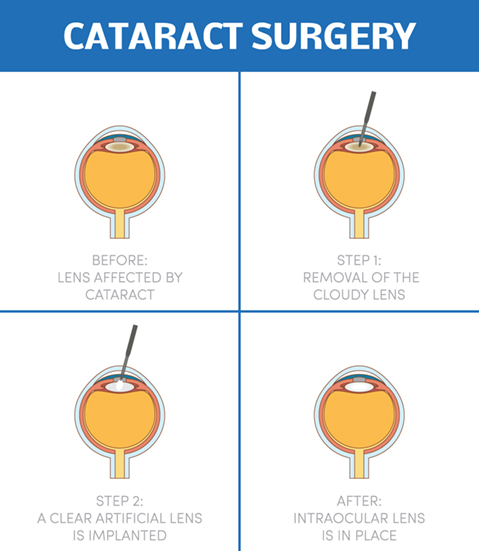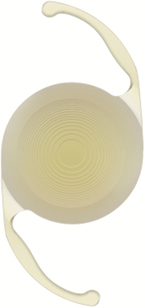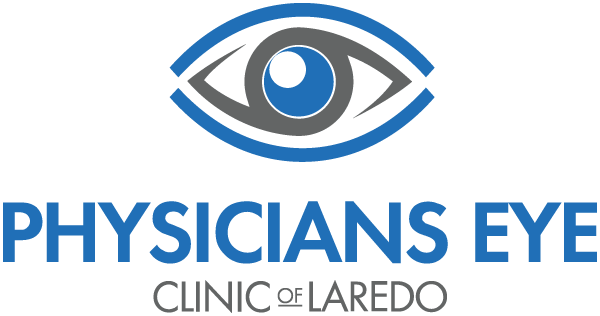Cataracts
Do you have hazy, foggy, or blurry vision? These are often some of the common signs of having a cataract.
If you have cataracts, you’re not alone because millions worldwide experience this age-related eye condition. The expert cataract surgeons at Physicians Eye Clinic of Laredo can treat your cataracts, helping you see clearly and return to what you love.

What is a Cataract?
A cataract occurs when the eye’s natural lens becomes cloudy, leading to impaired vision. The lens is found behind the iris and helps focus light onto the retina at the back of the eye.
When you have a cataract that forms on the natural lens, it causes the lens to become cloudy and affects your ability to see clearly. Cataracts are prevalent and are an almost inevitable part of the aging process. By age 80, most people either have cataracts or have had cataracts to remove them and improve their vision.
What are the Signs of Having Cataracts?
If you have a cataract, you may not realize it, at least initially. Some patients can have cataracts for years or even decades before cataracts start affecting their vision.
However, as cataracts continue developing, you may experience symptoms like:
- Blurry or foggy vision, like looking through a dirty window
- Noticing colors no longer look vibrant or seem more faded than before
- Finding it more challenging to see at night, making driving in the evening unsafe
- Seeing halos or glare around lights
- Experiencing double vision in only one eye
- Needing more frequent prescription changes for your glasses or contact lenses
- Requiring brighter light for fine-focus tasks like reading
If you have experienced these symptoms, schedule an appointment at Physicians Eye Clinic of Laredo. Your ophthalmologist can help you determine the next steps if you have cataracts.






How Do I Know If I Need Cataract Surgery?
If you have cataracts, it may not mean you need cataract surgery immediately. Early-stage cataracts likely won’t interfere with your vision.
However, if cataracts hinder your daily activities or affect your quality of life, it’s time to consider cataract surgery. Can you do things like:
- Make dinner for yourself?
- Clean your house?
- Take part in your favorite hobbies?
If cataracts have made it impossible to do even the simplest tasks for yourself because of your increasingly worsening vision, this is a sign that you should have them removed. The only way to treat cataracts is to have cataract surgery.
Cataract surgery is a common and safe procedure that removes and replaces your cloudy natural lens with an artificial lens called an intraocular lens (IOL). However, before your eye doctor can recommend cataract surgery, they will perform a comprehensive eye exam to assess your eyes’ health and measure your eyes.
These measurements will help your cataract surgeon determine the appropriate type and power of IOL for your visual needs.
What Should I Expect During Cataract Surgery?

Cataract surgery at Physicians Eye Clinic of Laredo is an outpatient procedure, meaning you’ll go home after it’s over. Before the procedure begins, you’ll receive numbing eye drops.
These eye drops ensure you won’t feel any pain during the procedure. If you’re nervous, you may receive a sedative to help you relax.
Once the eye drops can disperse over the surface of your eye, your cataract surgeon will create a small incision in your cornea. They will then break up the lens and the cataract into smaller pieces before gently removing them with phacoemulsification.
Next, they will implant your new intraocular lens (IOL) to replace your natural lens. The IOL will help you see clearly and become a permanent part of your eye.
The IOL will unfold, and there is no need for sutures or stitches. Your cataract surgeon may tap an eye shield over your eye to protect it.
Because cataract surgery is an outpatient procedure, you’ll go home after it’s complete. The procedure only takes about an hour to finish.
What is the Recovery Process Like After Cataract Surgery?
Once cataract surgery is done, you can begin the recovery process. You may experience itching, discomfort, or soreness as the numbing eye drops wear off.
This should dissipate after a day or two. You’ll be required to take prescription eye drops to treat inflammation and prevent infection.
If your cataract surgeon gives you an eye shield, you’ll need to wear this while sleeping, usually for about a week. The eye shield will help keep you from accidentally bumping or rubbing your eye in your sleep.
After cataract surgery, follow-up appointments are required. Your first one will be the day after your procedure to ensure healing is happening as it should.
You should be able to return to your normal activities after a few days and when your eye doctor clears you. However, you must avoid heavy lifting, strenuous activity, and swimming for about a month.
What Will My Vision Be Like After Cataract Surgery?
Most patients notice significant improvements in their vision after undergoing cataract surgery. Colors may look more vibrant, and things are seen more clearly and sharply.
Depending on the IOL you choose, you may still need visual aids for activities like reading or using your phone. However, you’ll have improved vision because your cataracts have been removed.
IOLs Offered at Physicians Eye Clinic of Laredo
Physicians Eye Clinic of Laredo offers our patients many IOLs, including:
Light Adjustable Lens
The Light Adjustable Lens is the first and only IOL that allows patients to customize their vision after cataract surgery. The premium IOL is made of a photosensitive material that enables it to adjust when exposed to ultraviolet light.
During cataract surgery, you’ll have your natural lens removed and replaced with the Light Adjustable Lens. After recovery, you’ll receive UV light treatments with a proprietary UV light delivery device (LDD). Before receiving light treatments, you and your ophthalmologist at Physicians Eye Clinic of Laredo will test drive potential visual outcomes with the Light Adjustable Lens to find the perfect vision for you.
The light delivery device applies a precise amount of UV light to the Light Adjustable Lens, which helps gradually adjust its power in response to your unique visual needs. You’ll continue receiving light treatments 2-4 times over several weeks to fine-tune your vision and bring it closer to your desired results.
Once your vision is where you want it, your ophthalmologist will lock in your sight with two final treatments, ensuring you can enjoy your vision for years to come. The Light Adjustable Lens is excellent for the highest customization and precision in post-cataract surgery vision.
You can achieve the crisp, sharp vision you want, whether that’s seeing at a distance, up close, or a combination of both. The Light Adjustable Lens is also well-suited to patients with astigmatism, making it worth considering if you want to correct this refractive error and improve your vision.
PanOptix Trifocal IOL

The PanOptix trifocal IOL is a trifocal IOL, meaning it provides crisp, seamless vision at all distances, including up close, at a distance, and everything in between. The PanOptix lens has three distinct focal points, allowing you to see clearly across a broad spectrum of distances without compromising any particular range of your vision.
The PanOptix trifocal IOL is especially well-suited for patients who want to lead an active lifestyle. Whether you like to golf, have a killer backswing on the tennis court, or backstroke every morning to stay healthy, the PanOptix trifocal lens can help you stay healthy and reduce your dependence on visual aids. The PanOptix trifocal IOL also features advanced technology to reduce halos and glare around lights, meaning you’ll have better sight in low-light conditions.
Toric IOL

Many patients with cataracts also have a refractive error called astigmatism. Astigmatism occurs when your cornea or lens is irregularly shaped, leading to distorted or blurry vision at all distances.
Toric IOLs are specifically designed to correct astigmatism, providing patients with improved visual acuity. They may also reduce dependence on visual aids like glasses and contact lenses after cataract surgery. Many premium IOLs like the PanOptix trifocal lens and the Light Adjustable Lens also come in toric models.
Do you need cataract surgery?
Schedule your cataract evaluation at Physicians Eye Clinic of Laredo in Laredo, TX, to learn more!
